For me, elephants are Africa. They are the first animal I think of when people mention the African continent. Perhaps it’s their size that makes them so prominent in my associations with Africa. Or perhaps it’s their intelligence, sense of community or vulnerability that makes me think of them so often. Whatever it is, after seeing elephants in Uganda’s Queen Elizabeth National Park, they have cemented their place as one of my favorite creatures, whose future and survival I have become very interested in.
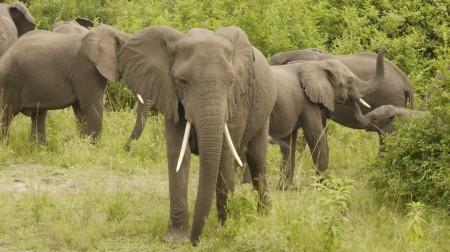
When most people think of African elephants, they are likely to conjure up images of herds roaming the Serengeti plains. For me however, I will now always think of them as strolling on the road and browsing in the bushes of Queen Elizabeth National Park in Uganda.

Queen Elizabeth National Park was established in 1954, a couple of years after Elizabeth II became Queen while she was visiting Kenya in 1952. The park is quite unique in that it has several volcanic cones and crater lakes with high salt content, which makes for highly desirable watering holes for the park’s bird and animal residents, including elephants. At nearly 2,000 square kilometres, the park is big enough to be populated by elephants and has almost 100 different mammal species.
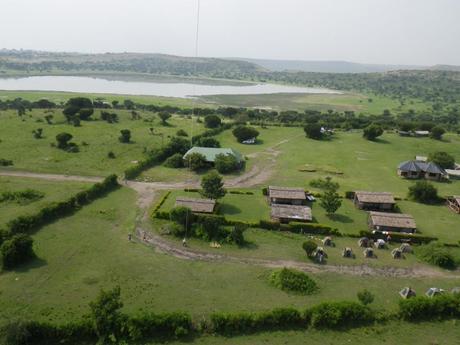
We were bound for ‘Hippo camp’ which is set some way into Queen Elizabeth Park and during the bumpy drive we saw our first elephants in the distance on the savannah grasses surrounded by Acacia trees.
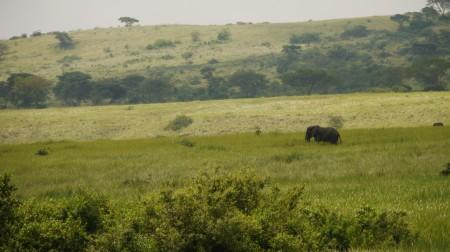
They seemed serene – probably because we were far enough away not to cause any bother, so they could carry on grazing in peace. The next group we came across however were a bit more put out because we were using their track (the road). They of course had the right of way, so while we waited, we all hung our heads out the window staring until they ambled away.
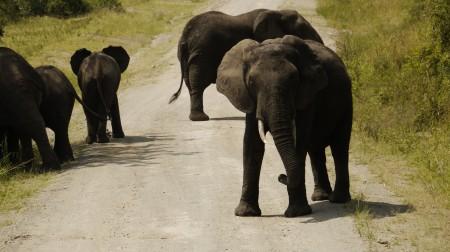
Later that afternoon, after setting up camp, we went for a game drive. A little way down the road and we saw elephants again, this time a larger family, with one very distinguishable member. One of the young bulls had a shortened trunk – probably amputated by a crocodile our guide told us. This reduction in length didn’t appear to affect his confidence however, as he stared at us somewhat defiantly, with a flaring of ears.
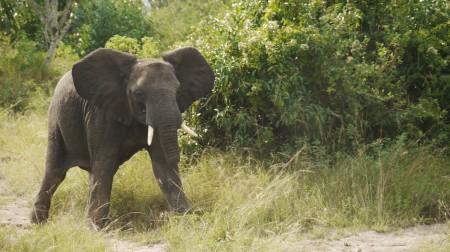
The other family members were strewn across the road, with some in bushes. You could clearly tell that this was a crossing point for them, with a defined track through the scrub. We really understood how close-knit this unit was when one of the elephants was cut off from the family on the other side of the road, and trumpeted distress calls to its fellow herd members. We moved on, allowing the herd to reunite, but it left an uneasy feeling as I realised how devastated elephants must be when they lose a relative. You could really empathise with the panic, and then the relief when the clan was back together.
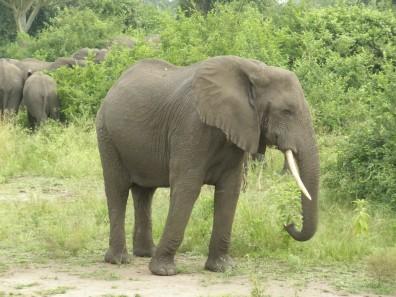
The next day we saw more examples of kinship among elephants as we came across a family of about a dozen elephants. This family had a couple of calves, who were closely guarded and clung to their mothers and sisters. The size contrast is almost comical, as they trot along somewhat similar to little lambs. Their tails sway from side-to-side almost in time with the accompanying adult. We had seen this same innocence and trust at the David Sheldrick elephant orphanage, except this time, rather than a bond with a human, there was the strong attachment to their mother or female relative. We saw a little one by itself become aware it was more than the usual few metres away from its guardian, and there was a look of disorientation, followed by desperation, and then a quick bolt back to the mother. I thought about the terror these poor little mites must experience at the loss of their mother, particularly the trauma of seeing this happen at the hands of poachers.
Elephants’ tusks are so instrumental to their survival. We saw several elephants who had one tusk longer than the other, indicating which side it favoured for scratching, digging, manoeuvring branches, and fighting. We also saw an elephant who had lost an entire tusk, giving it a lop-sided, asymmetrical look. The biggest tusks appeared to belong to the Matriarch who made her role of authority clear by staring us down, fanning her ears in a look of disapproval.
One of the most striking things about elephants is that despite their size, they have a resounding gracefulness and elegance about them. They carry their weight well, and despite ranging from 4,000 – 7,000 kgs, they can be incredibly agile when they need to be.
They also seem to have very distinguishable personalities. While one would be brave and flap her frilled, veiny ears, another would shy away in the bushes, meanwhile another curious but reserved one watched us from a distance. Perhaps these are as much signs of the roles they play, as they are personality traits – especially when you think about the research that has found elephants can work in teams.
It’s probably these human-like behaviours, which people find so captivating about elephants, and bring hoards of visitors to Africa’s parks and plains every year. I just hope that this intrigue of observing elephants in the wild will drown out a different and dark kind of captivation……..the one that sees hundreds of elephants slaughtered each year so their tusks can be turned into trinkets.
I had hoped to finish this blog on a more positive note, but there is a stain on my memory of these beautiful elephants. A few days after returning home from Africa we learnt that 11 elephants had been killed in Kenya – a similar size to the family we’d observed in Queen Elizabeth National Park. It was reported as the worst poaching massacre in decades. I really felt like I’d been punched in the stomach. It makes no sense. The only redeeming thought I have is of the selfless dedication and un-wavering commitment from the likes of the David Sheldrick Wildlife Trust and the Kenya Wildlife Service. Thank you.
News references
BBC News Online, 8 January 2013
The New York Times, 7 January 2013
General references
Wikipedia
The Two Thirsty Travellers love hearing other travellers’ stories, so leave us a comment about your elephant encounters.

